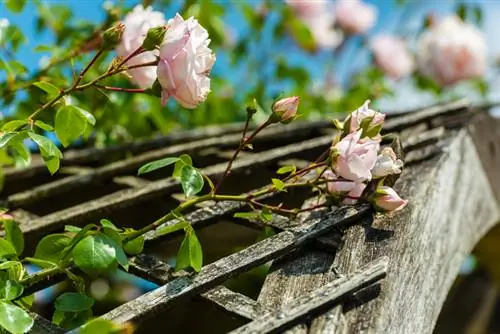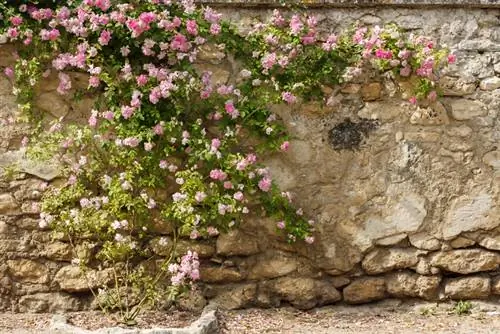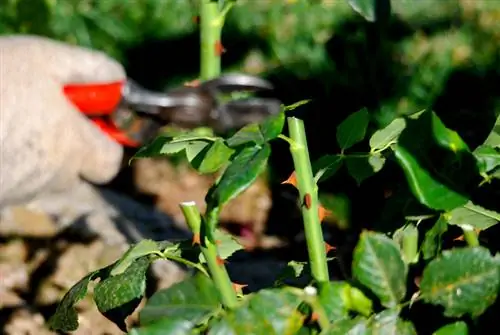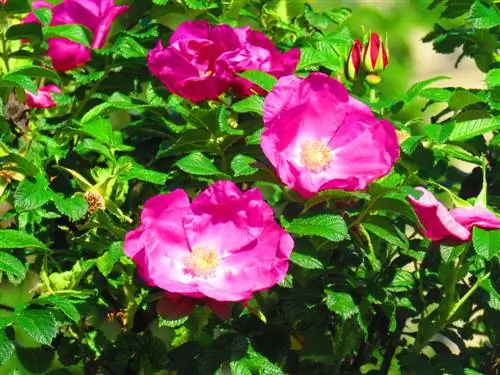- Author admin [email protected].
- Public 2023-12-16 16:46.
- Last modified 2025-01-23 11:20.
Climbing roses are available in many different varieties, shapes and colors and, depending on the type and variety, grow up to ten meters high and up to five meters wide. The spreading climbers require climbing aids for climbing and are primarily used to add foliage to fences, pergolas, arbors or trellises. However, you have to do something to ensure lush growth and beautiful blooms, because climbing roses - like all roses - need careful care.
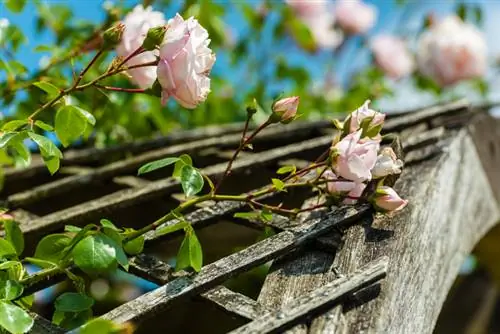
How do you properly care for climbing roses?
Climbing roses require regular watering, ideally in the evening or morning, proper fertilization, pruning according to their type and variety, and winter protective measures. You should also pay attention to pests and fungal infections to ensure he althy growth and beautiful flowers.
How often should you water climbing roses?
Climbing roses should be watered heavily, especially shortly after planting, as the plant will find dry phases very unpleasant during this time. Otherwise, the actual water requirement is usually overestimated, because a well-rooted climbing rose can usually supply itself with sufficient moisture. You should only water climbing roses on very hot and dry summer days, although you should always water from below and never wet the leaves - the foliage is very sensitive to moisture and is often colonized by fungi. It is also best to water in the evening or morning, but not in the midday heat.
When and how are climbing roses fertilized?
The vigorously growing climbing roses with their numerous leaves have a very high nutrient requirement and should therefore be fertilized regularly. Fertilization is not necessary in the year of planting (as long as you enriched the excavated soil with compost when planting), but it should be done in the following year from the start of the growing season. Both organic and synthetic fertilizers are suitable for fertilization, although experience has shown that compost etc. is preferred. With mineral fertilizers, there is always the risk of overdosing and thus weakening the plants, which in turn become more susceptible to infestation with fungi and/or pests.
Can climbing roses also be grown in pots?
In principle, you can also cultivate climbing roses in a pot, although the planter should be as large and deep as possible. Roses are deep-rooted, so the pot should not only be at least 40 centimeters wide, but also just as deep. Climbing roses kept in pots also require regular water and fertilizer.
How often should you repot climbing roses kept in a container?
Container roses are ideally moved to a larger pot every three to four years, with the ideal time for this being spring.
Can you cut climbing roses? If so, how is such a cut done?
Like all roses, climbing roses need to be pruned to ensure strong growth and beautiful blooms. The timing and frequency of cutting depend on the species and variety. So-called rambler roses are only cut once a year immediately after flowering, whereas climbers, which bloom several times a year, are cut several times.
What pests and diseases should you pay particular attention to in climbing roses?
Unfortunately, roses are quite susceptible to various fungal diseases, especially if they are not cared for properly, especially powdery mildew, gray mold (Botrytis), rose leaf spot, rose rust and star sooty mildew. Iron chlorosis often occurs when fertilization is inadequate or incorrect. There are also various pests that feel particularly comfortable in the succulent foliage of the climbing rose.
Are climbing roses hardy?
Basically, most climbing roses are very hardy, but you should still follow a few rules when overwintering:
- Do not cut roses before or in winter.
- Overwinter container roses cool but frost-free.
- Alternatively, wrap container roses well and protect them against frost.
- Mulch planted specimens in the root area.
Tip
Due to a lack of suitable adhesive organs, climbing roses are unable to climb independently. They need a climbing aid and their shoots also need to be guided.

